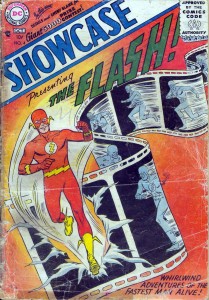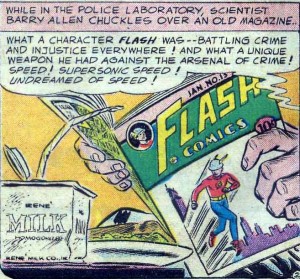Last week, I bashed the nostalgia-ridden Flash Rebirth, by Geoff Johns and Ethan Van Sciver. My main complaint was that the comic was less a narrative than a creepy love letter to Barry Allen and Flash stories from the Silver Age (roughly 1956-1970). Most of the comments more or less agreed with my criticism, but Alex Buchet indirectly defended Johns and Van Sciver by mentioning that he too appreciated the old Flash comics. I had never actually read the comics myself, though I was vaguely familiar with the stories thanks to pop culture osmosis. In an effort to understand why these comics inspired so much affection, I decided to read the first few Barry Allen appearances. For this week, I go all the way back to the character’s debut in Showcase #4.
Showcase #4 (Oct. 1956)
Writer: Robert Kanigher
Penciler: Carmine Infantino
Inker: Joe Kubert
A quick history lesson: the first superhero named the Flash was Jay Garrick, who deputed in Flash Comics #1 (1940). The superhero genre suffered a decline of popularity in the late 1940s, and Flash Comics was canceled in 1949. Jay Garrick completely disappeared from DC Comics’ publications by the early 1950s. But in 1956, DC launched a new superhero, a re-imagining of the Flash created by Robert Kanigher, John Broome, and Carmine Infantino.
The story begins with police scientist Barry Allen sipping homogenized milk with a straw (???) while reading an old Flash comic starring Jay Garrick. As early as 1956, there was already superhero nostalgia…
Though it’s worth noting that Jay Garrick was a fictional character in the world of Barry Allen.
The comic quickly proceeds through Flash’s origin story: he was struck by lightning while messing with volatile chemicals (what are the odds!). Rather than dying a horrible, burning death, Barry gained superpowers. And he got the exact same powers as his childhood hero (what are the odds!).
The key panel is a great example of Infantino’s skill…
I particularly like the use of onomatopoeia. The extension of the lightning “craaaaaack,” the brilliant blue contrasted against a yellow background, and the use of jagged lettering all increase the intensity of the moment.
The comic then moves through several scenes where Barry shows off what he can do with his new-found speed. He outruns a taxi, stops a diner waitress from dropping her tray on the floor, and saves his girlfriend, Iris, from getting shot in the head.
Infantino does great work with the bullet scene. As the bullet moves closer to Iris, the panels transition to a close-up of Barry’s face. It’s a great way to highlight Barry’s emotional reaction while maintaining the focus on the physical threat to Iris.
It turns out that Iris, a reporter and Lois Lane knockoff, was targeted by the criminal Turtle Man – The Slowest Man on Earth! Barry Allen decides to follow in the footsteps of Jay Garrick and becomes the new Flash, and being a superhero in the 50s means you get a sleek, Space Age costume. But even snazier than the costume is the capsule ring where he stores it…
Our hero runs around town and confronts the Turtle Man, who proceeds to humiliate the Flash “looney tunes” style. By that, I mean Turtle Man draws a silhouette of himself against a wall and Flash runs right into it. It may sound stupid, but the unabashed silliness of the comic is actually rather endearing. And then there’s the fact that Turtle Man’s costume is (are you ready for this?) – a turtleneck sweater.
It’s easy to understand why this book appealed to young boys. Action-adventure, sci-fi, cool toys, goofy humor, eye-catching art: this story has nearly everything a young reader could want.
Unfortunately, the second story in Showcase #4 is much less impressive. A generic villain from the future (who looks exactly like Lex Luthor) steals some stuff and the Flash stops him. The art remains decent, but none of the pages stand out.
I’m still on the fence regarding Silver Age Flash. I can see its potential. It’s light-hearted, unpretentious, briskly paced, and produced by competent (if not brilliant) professionals. But I can also see why the Flash never enjoyed the stratospheric success of characters like Spider-man. Barry Allen is a blank slate, lacking even a rudimentary personality. And I question whether super-speed can ever be visually compelling enough to sustain reader interest over the long run.
But I’ll give the Flash another try next week, when I read the first few issues of his solo comic.







Hi, Richard. That’s a fair and balanced (not in the Fox News sense) appreciation of those old Flash comics.
To be fair, the good stuff is a ways down the road, when Bob Kanigher was replaced by John Broome and Gardner Fox as scripter.
There was a terrific Broome tale featuring villain Mirror Master. He was miffed because “Wanted” posters only placed him as public enemy # 25 with $10 000 reward or whatever, so he decided to up his rankings by embarking on a crime spree.
However, every crime was frustrated by the Flash, and poor MM had to see his ranking keep dropping on the posters with every failure. Towards the end, I think he was public enemy # 4567, with a reward offered of $ 0.75…sob…
“Flash” was deliberately lightweight stuff,more so even than its DC contemporaries. I liked that quality as a kid. I liked Infantino’s elegance and inventiveness, his poised and angular women, his utopian cityscapes.
Not great art, not even great comics art, but worthy for its unpretentious fun and wit.
I look forward to your follow-up post!
I liked the note about nostalgia at the inception of the Silver Age; the more things change….
I hadn’t realized Kanigher was involved. He shows up everywhere (not necessarily for good.)
the best thing about those old flash comics was often the covers. They kept putting Flash through all these ridiculous transformations — the one where his head grows to the size of a giant watermelon was an especial favorite….
My 9 year old loves those old Barry Allen silver-age comics. She rejects Wally West out of hand now (although she did like a few of the Grant Morrison-penned issues).
I’ve always liked Infantino as an artist…and when the stories start getting goofier, the combination works pretty well…
Has your daughter read Crisis on Infinite Earths? Probably best to keep her away from that. She’d be outraged by the story and grow up to be Geoff Johns 2.0.
The goofiness of the Flash (or at least this first issue) is very appealing to me, which is surprising, because I’m not a huge fan of some of the other goofy Silver Age stuff like Weisinger’s Superman or Kanigher’s Wonder Woman. Maybe after I read a few more issues I’ll be able to put my finger on why it works better in the Flash.
Noah- I don’t think any of the early Flash issues have those transformations, but I’ve seen a few of those covers. I’m curious what your take on those is.
I think the covers are a lot more interesting than the stories!
There’s probably something to say about disempowerment fantasies with that stuff…I haven’t really thought about them a ton, honestly, other than to think they’re pretty funny….
The sequence with the bullet was likely orchestrated by Kanigher. The triptych was a would-be cinematic gimmick he went to again and again: a three panel sequence with a pan or a zoom, sometimes both. Infantino definitely nailed it here, though.
Maybe the best goofy Flash cover is the one where he is turned into a puppet and sports the classic thought balloon “Strange– I have the oddest feeling that I’m turning into a puppet!”
Chris K, thanks for the info. Your comment reminds me of Suat’s post from a while ago where he compared action scenes in video games (and movies) to action scenes in comics. A scene like the bullet moment probably wouldn’t have been easy to pull off on film until quite recently. In the post-“Matrix” era, stuff like that is easy. I imagine that scene was far more impressive to readers in the 1950s.
And I’ll post any funny covers I come across next week…
When the Flash works best is when it incorporates the science (and pseudo-science) of speed in clever ways. Likewise the science (and pseudo-science) of cold (Captain Cold), heat (Heatwave?), mirrors (Mirror Master), etc. Super-speed can be represented in a number of fun ways in the comics (lots of panels, motion lines, reverse-manga style blur, etc.) and some of the Silver-Age stuff took advantage of the visuals and the pseudo-sciency stuff.
Also Grodd. Any Grodd stuff usually works well.
Grodd = God.
Pingback: A fan receives Silver Age Comic Books in the mail part 2 | Silver Age Comic Books
Pingback: Speed Reading: Flash History – Blitz, Showcase, Hell to Pay and JLApe « Speed Force